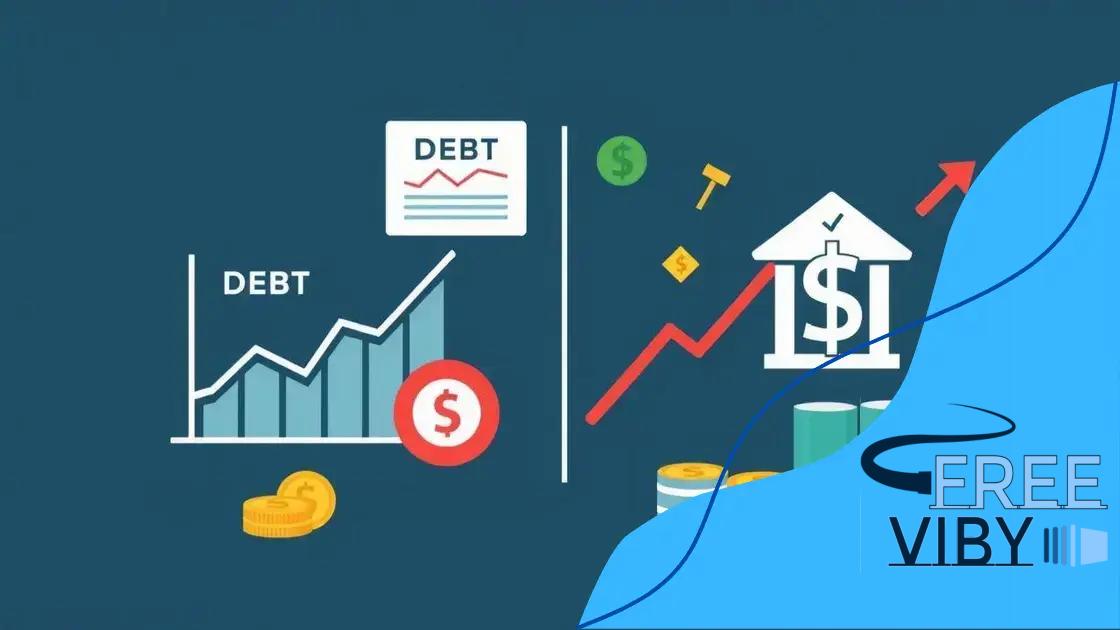Impact of rising debt levels on global financial markets

Anúncios
The impact of rising debt levels on global financial markets includes slower economic growth, increased interest rates, shifts in investment strategies, and the need for international cooperation to ensure stability.
Impact of rising debt levels on global financial markets is a pressing issue today. It’s interesting to think about how growing debt may influence markets and your financial decisions. In this article, we’ll explore these connections.
Anúncios
Understanding the current debt landscape
The current debt landscape is complex and constantly evolving. As nations grapple with financial challenges, understanding these dynamics is crucial for investors and policymakers. Today, many countries face unprecedented levels of debt, which can influence economic stability.
Factors Affecting Debt Levels
Several key factors contribute to the rising debt in various regions:
- Government spending
- Global economic conditions
- Inflation rates
- Interest rates
These elements not only shape national debt but also impact the global financial markets. For instance, when countries increase spending without a corresponding increase in revenue, their debt levels rise.
Anúncios
The Role of Economic Policies
Economic policies play a significant role in determining how swiftly a nation can address its debt issues. For example, fiscal policies aimed at stimulating growth can sometimes lead to higher debt levels if not managed carefully. Conversely, austerity measures might reduce debt but can also lead to economic slowdowns.
Moreover, international relations can influence a country’s borrowing capacity. Political stability often attracts foreign investment, which can assist in managing debt effectively. When countries are stable, investors are more likely to lend money, allowing governments to fund necessary projects.
Understanding Debt Types
It’s important to differentiate between various types of debt:
- Public Debt: Debt incurred by the government.
- Private Debt: Debt held by individuals and businesses.
- External Debt: Debt owed to foreign creditors.
- Internal Debt: Debt owed to creditors within the same country.
Each type of debt has different implications for the economy. For example, while public debt can finance essential services and infrastructure, excessive private debt might lead to a lack of spending and economic decline.
Ultimately, understanding the current debt landscape requires analyzing various components, including government strategies and global economic trends. By staying informed, individuals and businesses can make better financial decisions in response to these shifts.
Factors driving debt levels globally
The factors driving debt levels globally are multifaceted and important to understand for investors and governments alike. As economies grow, they often require additional funding, leading to increased debts.
Economic Growth and Spending
When a nation experiences rapid economic growth, it may increase spending to support infrastructure, healthcare, and education. This spending, while beneficial, often results in higher debt. Countries might borrow money to invest in future growth, expecting returns that outweigh the initial debt.
- Investment in infrastructure
- Funding for social programs
- Stimulus packages during downturns
However, unchecked spending can lead to unsustainable debt levels. Balancing growth and fiscal responsibility is a delicate act that many governments struggle with.
Interest Rates and Inflation
Interest rates significantly influence a country’s debt situation. Lower interest rates can encourage borrowing, leading to increased debt levels. Conversely, when rates rise, borrowing costs increase, which can help curb excessive debt but may also slow economic growth.
- Low interest rates promote borrowing
- High inflation can erode purchasing power
- Central banks play a critical role in managing rates
Additionally, inflation affects purchasing power and can decrease the value of existing debt, creating a complex scenario for both lenders and borrowers.
Global Events and Crisis
Events such as financial crises, pandemics, or geopolitical conflicts can significantly impact debt levels. During times of crisis, countries often increase borrowing to address economic challenges. For instance, the COVID-19 pandemic forced many governments to spend heavily on health systems and economic relief, which sharply raised debt levels.
Similarly, natural disasters or wars can strain national budgets. Countries may be forced to divert funds to recovery efforts, leading to increased borrowing.
The interplay of these factors shows that global debt levels are not just a result of national policies but also a response to broader economic conditions. Understanding these dynamics is vital for making informed financial decisions.
Effects of debt on interest rates

The effects of debt on interest rates are significant and can influence economic decisions at various levels. As debt levels rise, they can create changes in how interest rates are managed and perceived by markets and governments.
Debt and Its Influence on Interest Rates
When a country has high levels of debt, it can lead to higher interest rates. This happens because lenders perceive more risk when they lend money to a heavily indebted country. To compensate for this risk, they may charge higher interest rates.
- Increased borrowing costs
- Influence on inflation expectations
- Impact on consumer loans and mortgages
Higher interest rates can slow down economic growth as businesses and consumers face increased borrowing costs. This can lead to reduced spending and investment, further influencing the economy.
The Role of Central Banks
Central banks play a critical role in managing interest rates in response to debt levels. When debt is high, central banks may decide to keep rates low to stimulate the economy. Low rates can encourage borrowing, helping to boost economic activity.
However, if inflation starts to rise, central banks may need to increase interest rates to avoid an overheated economy. This balancing act is crucial for maintaining economic stability.
Market Reactions
The market’s reaction to debt can also influence interest rates. Investors often assess risk levels based on a country’s debt situation, which can lead to bond yield fluctuations. If investors feel a country is over-leveraged, they may demand higher yield on government bonds, effectively raising interest rates.
This relationship means that rising debt can create a cycle where increasing rates can further strain a country’s ability to manage its debt. As interest payments grow, governments may face budget challenges, leading to a need for even more borrowing.
Overall, understanding how debt affects interest rates is crucial for grasping the broader economic landscape. The dynamics between these factors can influence both national policies and individual financial decisions.
Debt impact on investment strategies
The debt impact on investment strategies is significant and can shape how investors approach their portfolios. As debt levels rise globally, they can influence market conditions and investor behavior.
Understanding Risk Exposure
High levels of debt can elevate risk in financial markets. When governments or companies are heavily indebted, it can lead to greater volatility. Investors often reassess their risk exposure based on these factors, leading them to adjust their strategies.
- Reallocating investments based on risk assessment
- Shifting towards safer asset classes like bonds
- Diversifying to mitigate potential losses
This reassessment can lead to a flight to quality, where investors prefer safer investments over riskier ones, such as stocks of heavily indebted companies.
Interest Rates and Investment Choices
As previously discussed, rising debt can influence interest rates. Changes in interest rates affect different investment vehicles. For example, when rates go up, bond yields tend to rise, making them more attractive compared to stocks.
Investors may shift their focus from equities to fixed-income securities, seeking the stability that bonds can provide. This transition can affect stock prices, leading to a downward pressure on equities during times of high debt.
Sector-Specific Impacts
The impact of debt varies across sectors. Some industries, like utilities and consumer staples, may be less affected by debt levels due to their stable cash flows. Others, such as tech or startups, might face more challenges in a high-debt environment.
- Utilities may maintain stable demand despite high debt
- Tech companies may rely on borrowing for growth
- Startups often face hurdles securing financing
Understanding which sectors are more resilient can help investors make informed decisions about where to allocate their resources.
In conclusion, the debt impact on investment strategies requires careful consideration. Investors need to stay aware of how debt levels can create both risks and opportunities in the market.
Future implications for global economies
The future implications for global economies in the context of rising debt levels are significant and warrant close attention. As countries accumulate more debt, the potential challenges and opportunities can reshape economies worldwide.
Economic Growth Trends
High debt levels can slow economic growth in the long run. If governments spend a large portion of their budgets servicing debt, less money is available for investments in crucial areas like infrastructure, education, and health. This can create a cycle where economic growth remains stunted, impacting overall prosperity.
- Investment in critical infrastructure may decline
- Reduced spending on public services
- Potential for prolonged economic stagnation
For developing nations, high debt can be particularly damaging, as they struggle more than wealthier countries to attract investment and foster growth.
Inflation and Monetary Policy
Rising debt may lead to increased inflation, especially if governments resort to printing more money to cover their obligations. Consequently, central banks might need to react by adjusting interest rates, which could impact borrowing costs for businesses and consumers alike.
Higher inflation can erode purchasing power and savings, giving consumers less incentive to spend. Conversely, in some scenarios, inflation might act as a relief valve allowing countries to pay off their debt in cheaper dollars, creating a complex balance.
Investment Shifts
As the global debt situation evolves, investors will likely reevaluate their strategies. Asset classes may experience rotations as investors seek safer options in response to increasing debt uncertainty. There can be a shift towards commodities, real estate, or bonds that are perceived as stable.
- Increased demand for gold and precious metals
- Focus on real estate as a hedge against inflation
- Interest in government bonds from stable economies
Understanding these trends will be essential for navigating future markets and adapting investment strategies accordingly.
Global Cooperation and Policy Changes
Finally, increased debt levels may necessitate greater international cooperation. Countries could face pressure to work together to address mounting debt crises, which may involve financial aid or restructuring debt agreements.
Policymakers must consider implementing strategies that encourage sustainable debt levels while promoting economic growth. This may include reforms in monetary policy, fiscal responsibility, or multilateral support frameworks to ensure global economic stability.
In conclusion, understanding the impact of rising debt levels on global financial markets is crucial for everyone from policymakers to individual investors. High debt can affect economic growth, influence interest rates, and drive changes in investment strategies. As we look to the future, being aware of these trends will help us navigate an ever-changing economic landscape. Collaboration among nations may become essential to manage and sustain economic stability, ensuring a balanced approach to growth while keeping debt levels in check.
FAQ – Frequently Asked Questions about the impact of rising debt levels on global financial markets
How does rising debt affect economic growth?
Rising debt can slow down economic growth as governments may allocate more funding to servicing debt instead of investing in essential services and infrastructure.
What is the relationship between debt and interest rates?
High debt levels can lead to increased interest rates as lenders perceive higher risk, which can affect borrowing costs for consumers and businesses.
How should investors adjust their strategies in a high-debt environment?
Investors may consider reallocating their portfolios to safer assets, such as bonds, and be cautious about investing in high-debt companies.
Why is international cooperation important in managing debt issues?
International cooperation is essential to address global debt crises, as collaborative policies and support can help stabilize economies and promote sustainable growth.






